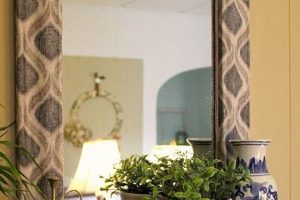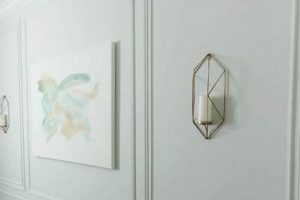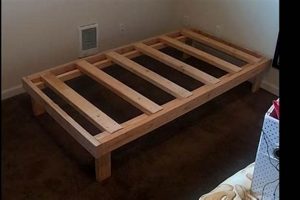The practice of crafting personalized visual displays using picture frames and varied imagery is a creative endeavor resulting in unique decorative pieces. This activity involves assembling a collection of photographs, artwork, or other flat memorabilia within a framework composed of individual or interconnected frames, typically arranged in a visually appealing manner. For instance, an individual may choose to create a decorative piece featuring family photographs within a series of repurposed wooden frames, mounted together to form a single, cohesive display.
Such projects offer a means of preserving memories and personal narratives, while also serving as distinctive elements of interior design. The act of curating and arranging these visual elements can provide a sense of personal satisfaction and creative expression. Historically, the creation of such arrangements represents an evolution from simple picture displays toward more complex and personalized forms of visual storytelling. The aesthetic value and personal significance contribute to its ongoing popularity across diverse cultural contexts.
Understanding the components, techniques, and design principles associated with this craft allows for the production of visually compelling and emotionally resonant displays. The following discussion will explore specific methodologies for selecting materials, arranging compositions, and executing the construction of these personalized artistic creations.
Guidance for Assembling Framed Visual Collections
The creation of aesthetically pleasing and structurally sound framed visual collections necessitates careful planning and execution. The following advice offers practical strategies for achieving optimal results.
Tip 1: Material Selection. Selecting high-quality frames and backing materials is paramount. Acid-free mat boards and UV-protective glass or acrylic are recommended to preserve the longevity of displayed photographs and artwork. Durable frame materials, such as solid wood or metal, contribute to the overall structural integrity of the final piece.
Tip 2: Compositional Planning. Before commencing the physical assembly, it is advisable to create a preliminary layout of the images and frames. Experiment with different arrangements on a flat surface to determine the most visually balanced and cohesive design. Consider the size, color, and subject matter of each image when arranging the composition.
Tip 3: Frame Compatibility. Ensure the frames selected complement the style and subject matter of the displayed images. A cohesive aesthetic can be achieved by choosing frames with similar finishes, colors, and profiles. Mixing different frame styles can be effective but requires careful consideration to maintain visual harmony.
Tip 4: Secure Mounting Techniques. Employ appropriate hanging hardware and techniques to ensure the secure and stable mounting of the finished piece. The weight of the framed collection must be considered when selecting hanging hardware. Professional-grade picture hangers or wire hanging systems are recommended for heavier displays.
Tip 5: Precision Cutting and Fitting. Accurate measurements and precise cutting of mat boards and backing materials are essential for a professional-looking finish. Utilize a mat cutter or a straight edge and sharp utility knife to ensure clean, accurate cuts. Proper fitting of the image within the frame prevents slippage and protects the displayed item.
Tip 6: Consideration of Wall Space. Evaluate the available wall space and ambient lighting conditions before finalizing the design. The size and orientation of the framed collection should be proportional to the dimensions of the wall. Avoid placing the display in direct sunlight, which can cause fading and damage to the displayed images.
Tip 7: Leveling and Alignment. Precise leveling and alignment are crucial for achieving a visually appealing and professional presentation. Use a level to ensure the framed collection hangs straight and evenly. Accurate alignment of multiple frames within a larger composition is essential for a cohesive aesthetic.
Adhering to these principles will contribute to the creation of a visually engaging and structurally sound display, preserving memories and enhancing the aesthetic appeal of the surrounding environment.
The subsequent sections will elaborate on specific design principles and advanced techniques for creating intricate and personalized displays.
1. Material Quality
The selection of materials significantly influences the final aesthetic, durability, and archival properties of a framed visual collection. The inherent characteristics of each component directly impact the long-term preservation and visual appeal of the assembled piece.
- Frame Composition and Stability
The structural integrity of the frame is paramount. Solid wood, metal, or high-density polymers offer superior stability and resistance to warping or breakage compared to less robust materials. The choice of frame material directly affects the weight-bearing capacity and the overall longevity of the display. For instance, a collection incorporating heavier items necessitates a frame constructed from a durable material like solid hardwood or steel.
- Matting and Backing Acid-Free Properties
The selection of acid-free matting and backing boards is crucial for preventing the degradation of displayed photographs and artwork. Acidic materials can leach into the displayed items, causing discoloration, embrittlement, and eventual deterioration. Archival-quality matting and backing create a protective barrier, ensuring the long-term preservation of the visual elements within the frame. An example is using lignin-free matboard to prevent yellowing of vintage photographs over time.
- Glazing UV Protection and Clarity
The choice of glazing material, whether glass or acrylic, plays a significant role in protecting the displayed items from harmful ultraviolet (UV) radiation. UV-protective glazing filters out damaging rays that can cause fading and discoloration. Additionally, the clarity and refractive index of the glazing material affect the visual presentation of the artwork or photographs. Museum-grade acrylic, for example, offers superior UV protection and clarity compared to standard glass.
- Adhesives and Fasteners Archival Safety
The adhesives and fasteners used in the assembly process must be archival-safe and non-reactive with the displayed items. Acidic adhesives can cause staining and degradation, while corrosive fasteners can damage delicate artwork or photographs. Neutral pH adhesives and stainless steel fasteners are recommended for ensuring the long-term stability and preservation of the framed visual collection. For instance, using acid-free linen tape for hinging artwork to the matboard prevents damage over extended periods.
The careful consideration and selection of high-quality, archival-safe materials are essential for creating a framed visual collection that is both aesthetically pleasing and capable of withstanding the test of time. The implementation of these principles ensures the preservation of cherished memories and artistic creations for future generations.
2. Layout Composition
Layout composition, in the context of framed visual collections, directly determines the aesthetic impact and narrative coherence of the finished piece. The arrangement of individual frames and their contents within the overall structure dictates how the viewer’s eye moves across the display, influencing the interpretation and emotional response. Poor layout choices can result in a visually disjointed or confusing presentation, diminishing the impact of the individual elements. Conversely, a well-considered layout enhances the individual elements and creates a cohesive, engaging whole. For example, arranging images chronologically within a sequence of frames can tell a story, while grouping images by color palette can create a harmonious visual effect.
The practical application of layout principles involves considering factors such as balance, symmetry, asymmetry, and the strategic use of negative space. Symmetrical arrangements offer a sense of order and formality, while asymmetrical compositions can create a more dynamic and visually stimulating effect. The sizes and shapes of the frames, as well as the dimensions of the images within, must be carefully considered to achieve a balanced composition. Furthermore, the spacing between frames and the use of matting can significantly impact the overall visual flow. Professionals often prototype various layouts on a digital platform or on the floor before committing to a final arrangement, ensuring the optimal visual hierarchy and narrative structure.
Effective layout composition is fundamental to a successful frame collage project. Challenges include balancing diverse imagery and accommodating varying frame sizes while maintaining visual coherence. Mastering layout principles enables the creation of impactful displays that not only preserve memories but also serve as meaningful artistic expressions, aligning with the broader goal of personalized interior design.
3. Frame Cohesion
Frame cohesion, in the context of framed visual collections, represents the degree of visual harmony and stylistic consistency among the individual frames comprising the larger assemblage. It is a critical component influencing the overall aesthetic impact and perceived quality of the completed work. Insufficient frame cohesion can result in a disjointed, visually jarring presentation, detracting from the intended narrative or artistic expression. Conversely, a high degree of frame cohesion contributes to a sense of unity, sophistication, and intentionality. The selection of frames exhibiting similar materials, colors, profiles, or styles directly impacts the perceived cohesiveness of the final display. For example, a collection employing frames constructed from reclaimed wood with a uniform finish demonstrates greater cohesion than an assortment of frames featuring disparate materials and finishes.
The effect of frame cohesion extends beyond mere aesthetics. A cohesive framework enhances the individual images or objects displayed, guiding the viewer’s eye and reinforcing the intended theme or narrative. The practical application of this principle involves careful consideration of frame selection during the planning stages of the project. Frame choice should be informed by the subject matter of the displayed items, the overall design scheme of the surrounding environment, and the desired aesthetic effect. A collection of black-and-white photographs, for instance, may benefit from frames featuring a consistent black or neutral finish, while a more eclectic assortment of artwork may accommodate a greater degree of variation in frame styles, provided a unifying element, such as a shared color palette or material, is maintained. The failure to address frame cohesion can lead to a cluttered, visually unappealing display that undermines the intended artistic or sentimental value of the collection.
Understanding and implementing principles of frame cohesion is essential for achieving visually successful and aesthetically pleasing framed visual collections. Challenges arise when incorporating disparate elements or working with pre-existing frame collections. However, strategic application of unifying elements, such as consistent matting or a shared color accent, can mitigate these challenges and achieve a cohesive overall effect. The pursuit of frame cohesion directly contributes to the creation of personalized and meaningful displays that enhance the visual appeal and emotional resonance of the surrounding space, aligning with the broader goals of interior design and personal expression.
4. Mounting Security
Mounting security represents a critical, often understated, aspect of framed visual collection projects. The stability and secure affixation of the assembled display directly impact its longevity, aesthetic presentation, and safety. Inadequate mounting can lead to damage, misalignment, or even complete detachment of the piece, resulting in potential injury and the loss of valuable or sentimental items.
- Weight Distribution and Load Capacity
The weight of the framed collection, encompassing frames, backing materials, glazing, and displayed items, must be accurately assessed to determine appropriate hanging hardware. Overestimating or underestimating the load capacity of the chosen hardware can compromise the structural integrity of the mount. For instance, a large assemblage of heavy frames requires robust wall anchors or mounting plates capable of supporting the cumulative weight, while lightweight arrangements may necessitate simpler hanging solutions. The failure to account for weight distribution can result in stress fractures, loosening of fasteners, and eventual failure of the mounting system.
- Wall Material Compatibility
The type of wall material dictates the appropriate type of anchor or fastener required for secure mounting. Drywall, plaster, concrete, and wood each necessitate different approaches to ensure a stable and reliable connection. Using inappropriate anchors for a given wall material can lead to slippage, stripping, or complete failure of the mount. For example, drywall anchors are specifically designed to distribute weight behind the thin, brittle surface of drywall, while concrete anchors provide a secure grip within the dense, unyielding structure of concrete. Understanding wall material compatibility is essential for selecting the correct hardware and ensuring a long-lasting, secure installation.
- Hanging Hardware Selection and Placement
The choice of hanging hardware, including hooks, wires, D-rings, and mounting plates, significantly influences the stability and aesthetic presentation of the framed collection. The selected hardware must be appropriately sized and rated for the weight of the display, and its placement must be carefully considered to ensure balanced weight distribution and prevent tilting or sagging. For instance, D-rings should be securely attached to the frame using screws or bolts, rather than nails or staples, to prevent pull-out. The placement of hanging points should also be symmetrical to ensure the display hangs level and balanced. Incorrect hardware selection or placement can compromise the structural integrity of the mount and detract from the overall visual appeal of the piece.
- Safety Considerations and Best Practices
Prioritizing safety during the mounting process is paramount. Wearing appropriate safety gear, such as eye protection and gloves, is recommended to prevent injury. It is also essential to carefully follow manufacturer instructions for the installation of hanging hardware. When mounting heavy or complex displays, it is advisable to seek professional assistance to ensure a safe and secure installation. Regularly inspecting the mounting hardware and the surrounding wall for signs of stress or wear is also crucial for maintaining the long-term stability of the display. Ignoring safety considerations can result in personal injury and damage to the framed collection.
These aspects of mounting security are integral to the successful execution of any framed visual collection project. The long-term preservation of the display, coupled with the safety of its surroundings, hinges on a thorough understanding and implementation of these principles. Thus, meticulous planning and execution are crucial for realizing a visually appealing and enduring work.
5. Visual Balance
Visual balance serves as a foundational element within the realm of framed visual collection projects. The arrangement of frames and imagery directly influences the perception of stability and harmony. An imbalance can create a sense of unease or incompleteness, detracting from the overall aesthetic impact of the display. The principles of visual weightdetermined by factors such as size, color, and complexitymust be carefully considered. Larger or more visually dense elements attract more attention and exert greater influence on the composition. Asymmetrical arrangements, where elements are not mirrored, require a nuanced understanding of visual weight to achieve equilibrium. For example, a large, dark-toned frame on one side can be counterbalanced by a cluster of smaller, lighter-toned frames on the opposite side. Failure to account for these dynamics results in displays that appear lopsided or unstable.
The practical application of visual balance involves several key strategies. Employing a consistent mat width around all images can create a unifying visual element that promotes balance, regardless of the individual image content. Utilizing frames of similar color or material contributes to a sense of visual cohesion, reducing the perceived weight discrepancies. Strategic placement of dominant visual elements, such as focal point images, is crucial. These elements should be positioned to draw the viewer’s eye and establish a sense of order within the composition. Furthermore, negative space, the areas of the display devoid of frames or imagery, plays a vital role in providing visual relief and preventing the composition from feeling cluttered or overwhelming. Professional designers often utilize mock-ups or digital tools to experiment with different layouts before committing to a final arrangement, ensuring that visual balance is effectively achieved.
In summary, visual balance is not merely an aesthetic preference but a fundamental principle governing the success of framed visual collections. Achieving it requires a comprehensive understanding of visual weight, careful planning of layout, and the strategic use of compositional elements. Challenges, such as accommodating diverse image sizes and orientations, can be overcome through meticulous attention to detail and a commitment to creating a visually harmonious whole. A well-balanced framed visual collection enhances the emotional impact and aesthetic appeal of the displayed items, contributing to a more enriching and engaging viewing experience. Ultimately, it reflects a thoughtful approach to personalized interior design and artistic expression.
Frequently Asked Questions
This section addresses common inquiries regarding the construction and implementation of framed visual collections, providing concise and informative responses to ensure optimal project outcomes.
Question 1: What constitutes the optimal adhesive for securing photographs within a framed visual collection?
The adhesive should be pH-neutral and specifically formulated for archival use. Acidic adhesives can degrade photographs over time, leading to discoloration and embrittlement. Opt for products labeled “acid-free” and “archival safe” to ensure long-term preservation.
Question 2: How does one mitigate the risk of damage from ultraviolet (UV) radiation when displaying framed visual collections?
Employ UV-protective glazing, either glass or acrylic, to filter out harmful UV rays. Direct sunlight exposure should also be avoided. Periodic rotation of displayed items can further minimize the cumulative effects of UV exposure.
Question 3: What is the recommended method for ensuring consistent spacing between frames in a multi-frame display?
Utilize spacers or templates to maintain uniform intervals between frames. Precision measurement and marking are essential for achieving a visually balanced and professional-looking arrangement.
Question 4: What is the most effective approach for cleaning framed visual collections without causing damage?
Use a soft, lint-free cloth to gently dust the frames and glazing. Avoid abrasive cleaners or excessive moisture. For persistent smudges, a specialized glass cleaner can be applied sparingly to the glazing only, taking care not to saturate the frame or displayed items.
Question 5: What factors should be considered when selecting hanging hardware for a framed visual collection?
Assess the total weight of the assemblage, the composition of the wall material, and the desired aesthetic. Opt for hardware with a weight rating that exceeds the actual weight of the collection. Ensure the hardware is compatible with the wall material to provide a secure and stable mount.
Question 6: How can one prevent the accumulation of dust and debris within a framed visual collection?
Regular dusting with a soft brush or microfiber cloth is recommended. Seal the back of the frame with archival-quality tape to prevent the ingress of dust and insects. Consider displaying the collection in a climate-controlled environment to minimize environmental pollutants.
These guidelines provide a foundation for addressing key challenges associated with framed visual collection projects. Implementing these practices ensures the creation of visually compelling and enduring displays.
The subsequent section will delve into advanced techniques for creating personalized displays.
Conclusion
The preceding exploration of frame collage diy has elucidated the multifaceted nature of this artistic endeavor. From the selection of archival-quality materials to the implementation of secure mounting techniques, each element contributes to the final aesthetic and enduring value of the constructed piece. Emphasis has been placed on material quality, layout composition, frame cohesion, mounting security, and visual balance, delineating their individual importance and synergistic effects.
The construction of framed visual collections, when approached with diligence and informed decision-making, transcends mere decoration. It becomes an exercise in preservation, personal narrative, and artistic expression. Consistent with these considerations, pursuing frame collage diy projects stands as a testament to the enduring value of tangible memory and thoughtful design, with lasting impact, and is to be treated as a professional endeavor.


![Build a Strong DIY Boxing Bag Frame [Project Guide] The DIY Hub: Creative Crafts, Repairs & Life Hacks Build a Strong DIY Boxing Bag Frame [Project Guide] | The DIY Hub: Creative Crafts, Repairs & Life Hacks](https://craftingdiycenter.com/wp-content/uploads/2025/07/th-2040-300x200.jpg)




